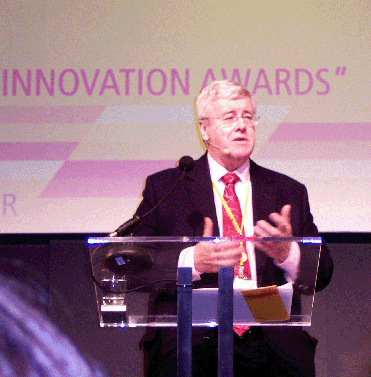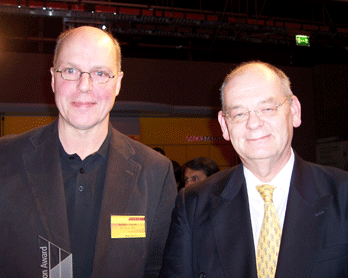|
Vol. 7 No. 137 WE COVER THE WORLD Wednesday December 10, 2008 |
 The
2008 Air India Cargo saga continues.
The
2008 Air India Cargo saga continues.
After that firm commitment recently from Air
India to Air Cargo News FlyingTypers that the cargo unit will continue, now
comes word that one of AI’s old Boeing 737-200s is on the block to be
sold to the Mukesh Ambani-led Reliance Fresh.
Reliance Fresh, as the name suggests, is the
retail outfit of Reliance Industries Ltd. (RIL) that is a huge purveyor of
vegetables and groceries all over India.
Though both Air India and RIL have refused to
comment on the sale directly there are indications from sources that Mukesh
Ambani could either go for an outright purchase of one of AI’s old Boeing
freighters or if that does not happen, perhaps a lease deal will be concluded.
Either way, Reliance according to media here
has embarked on an ambitious four-year plan to invest more than Rs 25,000
crore in its retail venture.
Earlier this year ACNFT reported that Mukesh
Ambani had joined hands with Naresh Goyal and bought seven percent of Jet
Airways.
The thought is that Naresh and Mukesh are a
good fit as both have strong ties in the air cargo business.
In any case the economic reality of December
2008 has cast a different perspective on those previously announced plans
that Reliance would acquire up to 40 airplanes to service its Reliance Fresh
outlets.
Late last year Reliance had said that it was
going to build a mixed fleet of cargo-carrying aircraft to move produce, vegetables
and other perishables from outlying centers in the country into metro retail
outlets in big metropolitan Indian cities.
Mukesh Ambani has called the scheme "farm
to fork".
Well the fork is also in the road to big plans,
as that scheme appears to be on the back burner for now at least, save for
maybe one old well traveled Air India B737 freighter.
For its part, Air India or the merged entity
of Air India and Indian, NACIL, has more than 140 aircraft in its fleet.
Of these, eight are freighters (four Boeing
737-200s and four Airbus A310-300s).
One of AI's B737 freighters was sold outright
to India Post, the government-owned postal department earlier this year.
Although Air India's Jitendra Bhargava, Executive
Director (PR), said that RIL had not approached the carrier “for an
outright purchase,” speculation about Air India selling its freighters
or other assets will continue to make news here as the airline combination
of AI and Indian Airlines now called NACIL in
2007-2008 delivered huge, unsustainable losses.
Tirthankar Ghosh
 Aviation
and space technology, automotive, medicine, the pharmaceutical industry and
science - those in general are the main drivers of innovative breakthrough.
But what about the logistics sector? So far their members have profited from
ideas other industries came up with—think of containers provided by the
maritime players, the RFID technology or the GPS navigation system that a growing
number of vehicles are equipped with.
Aviation
and space technology, automotive, medicine, the pharmaceutical industry and
science - those in general are the main drivers of innovative breakthrough.
But what about the logistics sector? So far their members have profited from
ideas other industries came up with—think of containers provided by the
maritime players, the RFID technology or the GPS navigation system that a growing
number of vehicles are equipped with.
To put an end to this trend, in March 2007 Deutsche
Post subsidiary DHL set up an Innovation Center in Troisdorf near Cologne. There,
their own experts together with industrial partners like IBM, Motorola or SAP
try to enhance the supply chain by developing innovative and practical solution
for every day’s work. So a think tank of 30 scientists, specialists and
innovators was formed, working in interdisciplinary projects for finding solutions
for a better, less costly and more environmental friendly flow of goods.
Now, a year and a half after being set up, some
leading brains were honored for their outstanding logistics solutions that have
been put into practice.
“The solutions from our DHL Innovation Center
open up new avenues to respond to tomorrow’s customer requirements,”
emphasized John Allan, (pictured left) Deutsche Post’s Chief Financial
Officer and Management Board Member.
The scope of innovations ranges from climate-neutral
shipments to the seamless monitoring of temperature-controlled high-tech medicines.
Deutsche Post’s own staff contributed many
of them. Acting as manager of the company’s patent applications, the DHL
Innovation Center collects ideas from their more than 500,000 employees and
assesses whether they might be suitable for patenting. The results of this effort
are about a 100 patents in Germany that Deutsche Post applied for last year.
One such patent license was awarded to a project called “Roboterzelle
Light”. It’s a machine created by DHL’s manager Hermann Franck
that enables faster sorting of packages by automatically lifting the items from
a standard pallet and putting them on a conveyor belt for further processing.
Franck was recognized for his sorting robot by the international jury, among
them Chris Caplice of the Massachusetts Institute of Technology, Professor Eckard
Minx of Daimler AG, Professor Michael Schenk of German think tank Fraunhofer
Institut and Doctor Keith Ulrich of the DHL Innovation Center.

Peter Landsiedel, (right) CEO of DHL Global Forwarding, Asia-Pacific
congratulating Hermann Franck (left) on his Innovation award.
Other DHL winners were Supriya Rao Patwardhan
and Ashish Saxena from Singapore that made it possible for customers to send
their shipment orders electronically. Thanks to their “eMailShip”
innovation more than 100,000 shipments have already been deployed that way.
In the category “Most Innovative Customer”
German retailer Metro AG was honored for introducing the RFID system at their
Future Stores all across France. Every year about 1.3 million pallets are given
radio labeling, enabling contactless and automatic monitoring along the supply
chain.
A second winner was the Allianz Group. Since July
this year the Munich-based insurance giant has sent its entire mail and advertising
letters climate-neutrally – making it more than 140 million items per
year. This was triggered by Deutsche Post’s offering of climate-neutral
door to door transports either by van, vessel or plane from origin to destination.
Next was a carbon-neutral warehouse DHL opened
Thursday on behalf of telecommunication client O2 in the United Kingdom. By
using geothermic energy for either heating or cooling the distribution center,
the yearly emission of 760 tons of greenhouse gases can be prevented. This is
the amount of carbon dioxide, 150 flights from London to Sydney, Australia and
back would blast into our atmosphere.
Heiner Siegmund